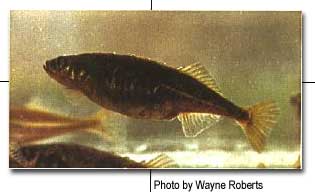

 |
 |
|

|
||||||||||||||||||||||||
| Description:
A small fish growing to about 87 mm in length. It is distinguished from all other Albertan species in having a series of 4-6 short isolated spines preceding the dorsal fin (there are only rarely more or fewer) and lacking bony plates on the side or tail region (minute and non-overlapping bony plates are present but only visible by staining the specimen). |
 |
The longest dorsal or pelvic spines, if present, are shorter than the eye diameter. In brook sticklebacks, as is true for many other species, the body is moderately compressed, the base of the pectoral fin is almost vertical and lies immediately behind the gill cover, and the caudal fin is slightly rounded at the terminal end (not indented or forked). The body color is quite variable but usually there is a mottling pattern on a dark olive-green background. Some individuals may have a silvery belly region; breeding males are black.
Remarks:
The brook stickleback is one of the commonest and most easily seen species of fish in Alberta. It is found throughout much of the province, occurring in both streams and lakes. In lakes it is most often seen, with patient observation, close to shore in or near rooted aquatic plants, either in schools or individually. They feed primarily on small aquatic insects and crustaceans. In turn, they are an important item in the diet of many other fishes and of many aquatic birds, mammals, and invertebrates.
Breeding takes place from late spring to early summer. Males will build a nest that is up to 35 mm in diameter by taking such items as algae and leaves of aquatic plants and binding them together with a thread-like substance secreted from the kidney. Females lay eggs within the nest and following fertilization the male will vigorously defend the nest and developing eggs until after hatching in a few weeks time. Nests may be observed with careful observation along shorelines from late May to early July.
In over 40 localities, mostly in Alberta, over 20% and up to 99 1/2% of the brook sticklebacks fail to develop the pelvic skeleton. In all localities various expressions of pelvic skeleton development may exist. This phenomenon, of presence or absence of a major structure with a genetic basis, is very unusual in fishes and is being studied by Dr. Joe S. Nelson.
For more information on the brook stickleback in Alberta and guide to the literature see Fishes of Alberta.
J.S. Nelson